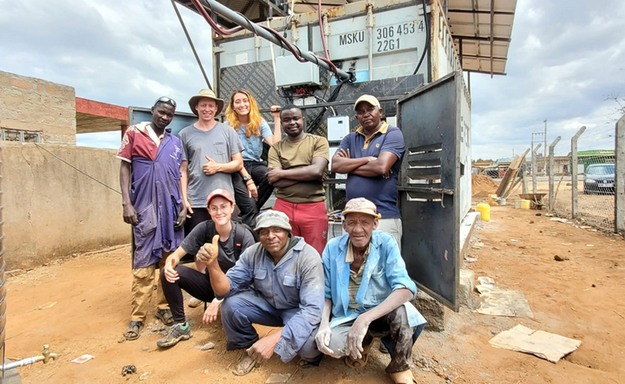The scientific principle, known as evaporative cooling, can be a game-changer for preserving fruits and vegetables grown on smallholder farms, where the wilting dry heat can quickly degrade freshly harvested produce. If those just-picked red peppers and leafy greens are not consumed in short order, or quickly transferred to cold — or at least cool — storage, much of it can go to waste.
Now, MIT  Professor Leon Glicksman of the Building Technology Program within the Department of Architecture, and Research Engineer Eric Verploegen of MIT D-Lab have released their open-source design for a forced-air evaporative cooling chamber that can be built in a used shipping container and powered by either grid electricity or built-in solar panels. With a capacity of 168 produce crates, the chamber offers great promise for smallholder farmers in hot, dry climates who need an affordable method for quickly bringing down the temperature of freshly harvested fruit and vegetables to ensure they stay fresh.
Professor Leon Glicksman of the Building Technology Program within the Department of Architecture, and Research Engineer Eric Verploegen of MIT D-Lab have released their open-source design for a forced-air evaporative cooling chamber that can be built in a used shipping container and powered by either grid electricity or built-in solar panels. With a capacity of 168 produce crates, the chamber offers great promise for smallholder farmers in hot, dry climates who need an affordable method for quickly bringing down the temperature of freshly harvested fruit and vegetables to ensure they stay fresh.
Verploegen has made evaporative cooling the focus of his work since 2016, initially focusing on small-scale evaporative cooling “Zeer” pots, typically with a capacity between 10 and 100 liters and great for household use, as well as larger double-brick-walled chambers known as zero-energy cooling chambers or ZECCs, which can store between six and 16 vegetable crates at a time. These designs rely on passive airflow. The newly released design for the forced-air evaporative cooling chamber is differentiated from these two more modest designs by the active airflow system, as well as by significantly larger capacity.
In 2019, Verploegen turned his attention to the idea of building a larger evaporative cooling room and joined forces with Glicksman to explore using forced, instead of passive, airflow to cool fruit and vegetables. After studying existing cold storage options and conducting user research with farmers in Kenya, they came up with the idea to use active evaporative cooling with a used shipping container as the structure of the chamber. As the Covid-19 pandemic was ramping up in 2020, they procured a used 10-foot shipping container, installed it in the courtyard area outside D-Lab near Village Street, and went to work on a prototype of the forced-air evaporative cooling chamber.
Here's how it works: Industrial fans draw hot, dry air into the chamber, which is passed through a porous wet pad. The resulting cool and humid air is then forced through the crates of fruits and vegetables stored inside the chamber. The air is then directed through the raised floor and to a channel between the insulation and the exterior container wall, where it flows to the exhaust holes near the top of the side walls.
For more information: news.mit.edu

